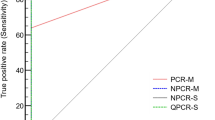Abstract
We assessed whether circulating cell positivity using RT-PCR for carcinoembryonic antigen (CEA) cDNA was affected by venesection via a needle compared/with a pre-aspirated venous cannula, and by increased PCR cycles. Systemic blood was sampled by needle and pre-aspirated cannula in 101 healthy individuals with no cancer history. After erythrocyte removal, samples were subjected to RT-PCR using specific primers for CEA, with 29 or 35 RT-PCR cycles. There was a significant difference between the number of subjects whose samples were negative when collected via needle venesection and positive when collected via pre-aspirated cannula, compared with positive by needle venesection and negative by pre-aspirated cannula for both 29 (P=0.016) and 35 (P=0.011) RT-PCR cycles. Venesection technique (P=0.01) and number of cycles (P=0.003) were significant predictors of a positive result. Positive results in healthy subjects were reduced to less than 3% when an aspirated cannula was used for venesection and >29 PCR cycles were avoided.
Similar content being viewed by others
References
Jonas S, Windeatt SAOB, Fordy C et al. Identification of carcinoembryonic antigen-producing cells circulating in the blood of patients with colorectal carcinoma by reverse transcriptase polymerase chain reaction. Gut 1996; 39: 717–21.
Peck K, Sher YP, Shih JY et al. Detection and quantitation of circulating cancer cells in the peripheral blood of lung cancer patients. Cancer Res 1998; 2761–5
Chomczynski P, Sacchi N. Single-step method of RNA isolation by acid guanidinium thiocyanate-phenol-chloroform extraction. Anal Biochem 1987; 162: 156–9.
Thompson J, Mossinger S, Reichardt V et al. A polymerase-chainreaction assay for the specific identification of transcripts encoded by individual carcinoembryonic antigen (CEA)-gene-family members. Int J Cancer 1993; 55: 311–9.
Leach, C. Tests for one sample or two related samples. In: Introduction to Statistics: A Non-Parametric Approach for the Social Sciences, pp 133–136. Chichester, UK: John Wiley and Sons 1979.
Dixon, W. Logistic regression. In: BMDP Statistical Software Manual, Release 7, pp 1105–1143. Los Angeles: University of California Press 1992.
Foss AJE, Guille MJ, Occlestone NL et al. The detection of melanoma cells in peripheral blood by reverse transcription-polymerase chain reaction. Br J Cancer 1995; 72: 155–9
Keilholz U, Willhauck M, Rimoldi D et al. Reliability of reverse transcription-polymerase chain reaction (RT-PCR)-based assays for the detection of circulating tumour cells: a quality-assurance initiative of the EORTC Melanoma Cooperative Group. Eur J Cancer 1998; 34: 750–3.
Funaki NO, Tanaka J, Ohshio G et al. Cytokeratin 20 mRNA in peripheral venous blood of colorectal carcinoma patients. Br J Cancer 1998; 77: 1327–32.
Castells A, Boix L, Bessa X et al. Detection of colonic cells in peripheral blood of colorectal cancer patients by means of reverse transcriptase and polymerase chain reaction. Br J Cancer 1998; 78: 1368–72.
Lemoine A, LeBricon T, Salvucci M et al. Prospective evaluation of circulating hepatocytes by alpha-fetoprotein mRNA in humans during liver surgery. Ann Surgery 1997; 226: 43–50.
Burchill SA, Bradbury MF, Pittman K et al. Detection of epithelial cancer cells in peripheral blood by reverse transcriptase-polymerase chain reaction. Br J Cancer 1995; 71: 278–81.
Wyld DK, Selby P, Perren TJ et al. Detection of colorectal cancer cells in the peripheral blood by reverse-transcriptase polymerase chain reaction for cytokeratin 20. Int J Cancer 1998; 79: 288–93.
Wharton RQ, Jonas SK, Glover C et al. Increased detection of circulating tumor cells in the blood of colorectal carcinoma patients using two reverse transcription-PCR assays and multiple blood samples. Clin Cancer Res 1999; 5: 4158–63.
Chelly J, Concordet JP, Kaplan JC, Kahn A. Illegitimate transcription: transcription of any gene in any cell type. Proc Natl Acad Sci USA 1989; 86: 2617–21.
Smith MR, Biggar S, Hussain M. Prostatic-specific antigen messenger RNA is expressed in non-prostatic cells: Implications for the detection of micrometastases. Cancer Res 1995; 55: 2640.
Bilchik A, Miyashiro M, Kelley M et al. Molecular detection of metastatic pancreatic carcinoma cells using a multimarker reverse transcriptase-polymerase chain reaction assay. Cancer 2000; 88: 1037–44.
Author information
Authors and Affiliations
Rights and permissions
About this article
Cite this article
Wharton, R., Patel, H., Jonas, S. et al. Venesection needle coring increases positive results with RT-PCR for detection of circulating cells expressing CEA mRNA. Clin Exp Metastasis 18, 291–294 (2000). https://doi.org/10.1023/A:1011034302639
Issue Date:
DOI: https://doi.org/10.1023/A:1011034302639




